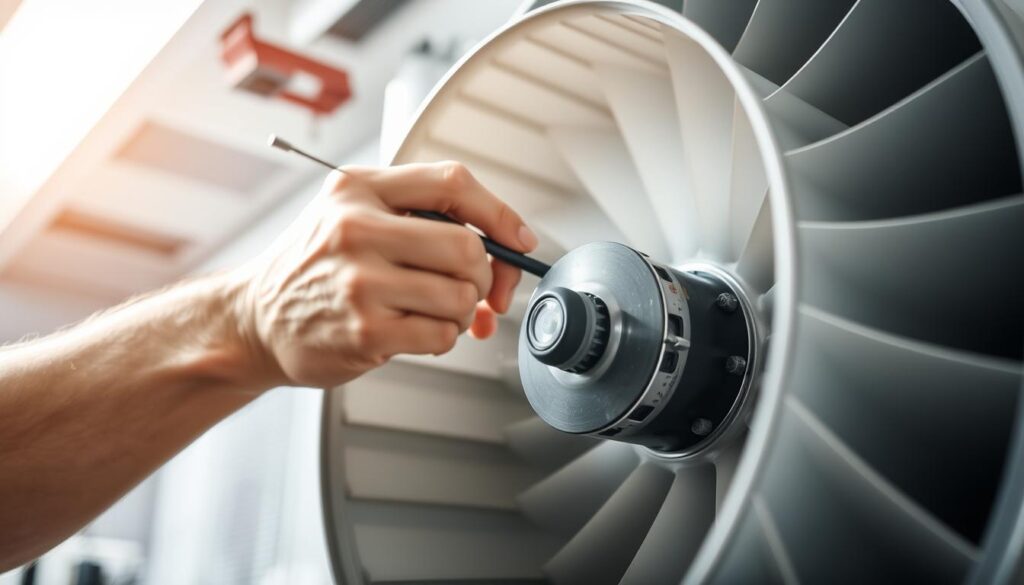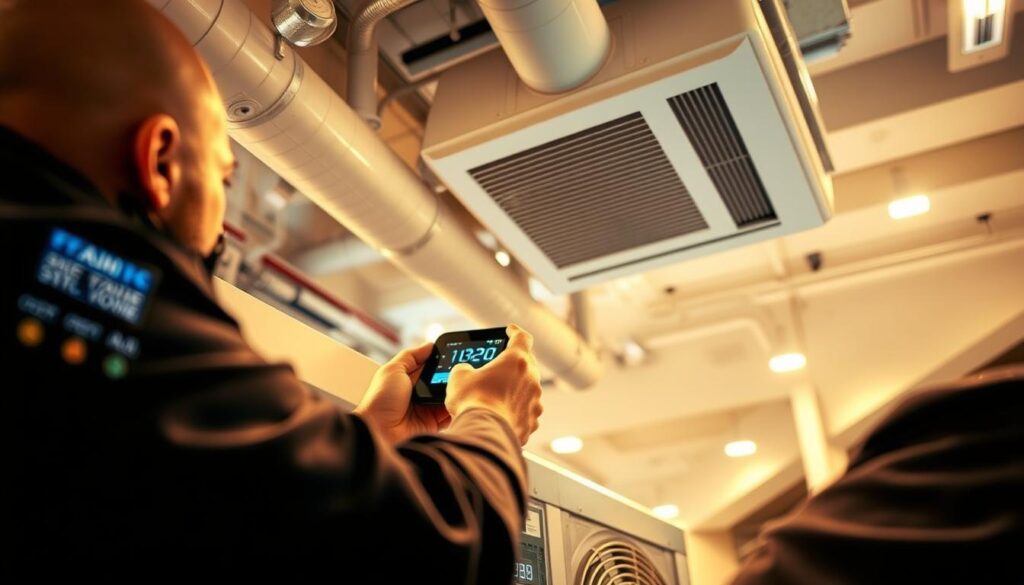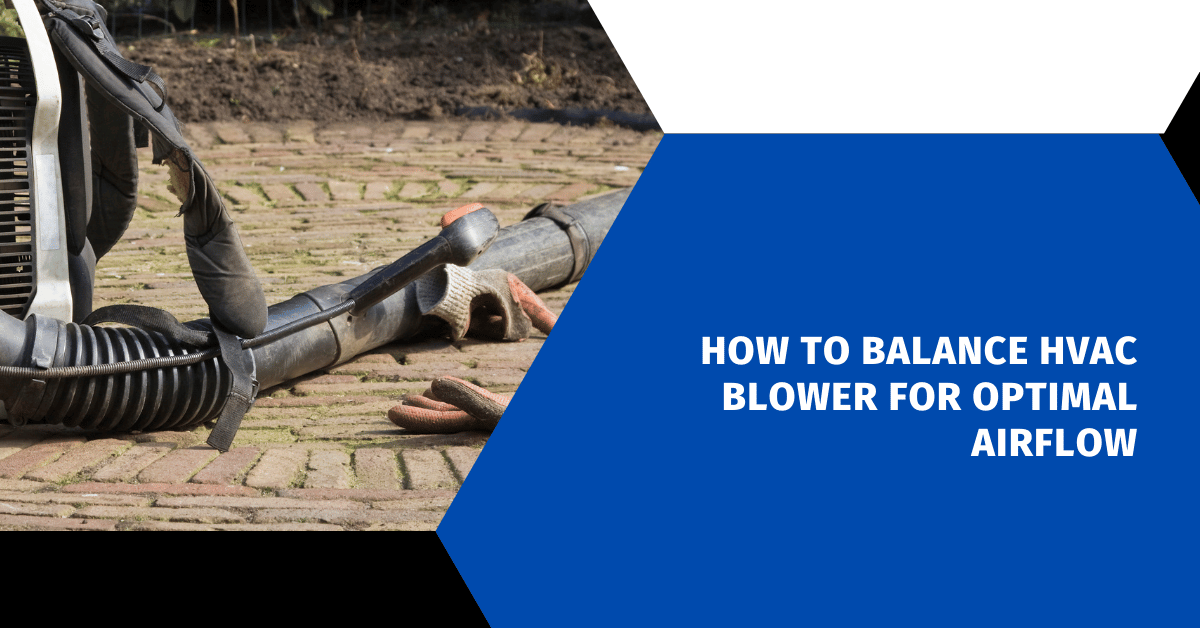Affiliate Disclosure
HVAC Guide Guys is a participant in the Amazon Services LLC Associates Program, an affiliate advertising program designed to provide a means for sites to earn advertising fees by advertising and linking to Amazon.
How to Balance HVAC Blower for Optimal Airflow? Ever noticed how some rooms in your home are freezing, while others are sweltering? The answer to this mystery is in balancing your HVAC blower for even comfort.

It’s not just about tweaking the mechanics. Balancing your HVAC blower is key to a cozy home. The blower wheel’s role is to spread air evenly, making sure every room gets the right amount of cool air.
Many homeowners don’t realize how crucial a balanced HVAC system is. If the airflow is off, you might see higher energy bills, less efficient systems, and uncomfortable rooms. By learning how to balance your blower, you can make your home’s temperature control better.
Key Takeaways
- Balanced HVAC systems improve overall home comfort
- Proper blower wheel balancing reduces energy consumption
- Temperature variations indicate potential airflow issues
- Regular HVAC maintenance prevents performance problems
- Professional assessment can optimize system efficiency
Table of Contents
Understanding HVAC Air Balancing Fundamentals
Your home’s comfort relies on a working HVAC system. Air balancing is key to making sure your heating and cooling systems spread air evenly. This ensures your home stays comfortable.
Air balancing is more than just tweaking your thermostat. It’s about fine-tuning your air handler to achieve consistent temperatures. This leads to maximum comfort in your home.
What is Air Balancing and Why It Matters
Air balancing means checking and adjusting your HVAC system’s airflow. It ensures your system works at its best. This can fix issues like fan vibrations and uneven temperatures.
- Identifies airflow inconsistencies
- Improves overall system efficiency
- Reduces energy consumption
- Extends HVAC system lifespan
Signs of an Unbalanced HVAC System
Spotting an unbalanced system is key to keeping your home comfy. Look out for these signs:
- Temperature variations between rooms
- Unusual noises from vents
- Increased energy bills
- Weak airflow in certain areas
Benefits of Proper Air Distribution
Proper air distribution makes your home better. By using air handler balance techniques, you get:
“Consistent comfort is the hallmark of a well-balanced HVAC system.” – HVAC Professional
- Uniform room temperatures
- Enhanced indoor air quality
- Reduced strain on HVAC components
- Lower energy costs
Knowing these basics helps you keep your home comfy and efficient.
Explore Our HVAC Shop
Looking for top-rated HVAC tools, parts, and accessories? Visit our shop and find the perfect solution for your needs.
Visit the ShopEssential Tools and Documentation for Balancing
Getting ready for HVAC system balancing needs careful planning and the right tools. Your furnace blower calibration starts with important documents and precise measuring tools.
Here’s what you’ll need for documentation:
- Detailed duct design calculations
- Complete duct layout diagrams
- Comprehensive equipment specifications
- Control system documentation
For accurate ac blower wheel alignment, you’ll need these measuring tools:
- Anemometers – measure air velocity and volume
- Digital manometers – assess pressure differences
- Precision thermometers – track temperature variations
- Differential pressure gauges – evaluate system performance
Experts suggest making a detailed checklist before starting. This makes sure you have everything you need, avoiding delays during calibration.
By spending time on preparation, you’ll make the HVAC system balancing smoother. This will also boost your system’s performance and efficiency.
Pre-Balancing System Inspection and Preparation
Getting your HVAC system ready for balancing needs a careful plan. Before you start adjusting the fan motor, do a full system check. This ensures everything works as it should.
Getting everything ready for squirrel cage fan balancing is key. Your checklist should cover important steps to make sure your system is ready.
Checking System Components
Start by looking at the system’s main parts:
- Check air filters for cleanliness and right fit
- Look at fan belts for tightness and wear
- Make sure electrical connections are secure
- Check if motor mounts are tight and straight
Verifying Operating Parameters
It’s important to measure key system factors:
- Make sure fan speed is as it should be
- Measure static pressure in different parts of the system
- Check temperature differences
- Use Cubic Feet per Minute (CFM) to measure airflow
Documentation Requirements
Keeping detailed records is vital for tracking system performance. Make a detailed log that includes:
- First system measurements
- Assessments of component conditions
- Baseline performance data
- Any issues found
By following these steps, you’ll lay the groundwork for successful HVAC system balancing. This ensures the best air flow in your space.
Explore Our HVAC Shop
Looking for top-rated HVAC tools, parts, and accessories? Visit our shop and find the perfect solution for your needs.
Visit the ShopHow to Balance HVAC Blower for Even Air Distribution
To get the best airflow from your HVAC system, you need to balance your blower. This requires careful steps and precise measurements. It’s all about making sure air flows evenly in your home.
- Digital airflow measuring device
- Anemometer
- Pressure gauge
- Notebook for recording measurements
The main steps for balancing airflow are:
- Measure the airflow at each register
- Compare these measurements with your system’s design specs
- Find areas where air isn’t distributed evenly
- Adjust dampers and vents a little at a time
- Check and adjust the airflow again
“Precision is the cornerstone of effective HVAC system airflow adjustment.” – HVAC Professional
Important things to keep in mind during balancing include:
| Factor | Importance |
|---|---|
| Register Size | Determines airflow volume |
| Duct Configuration | Impacts air pressure and distribution |
| System Design Specifications | Provides baseline for adjustments |
Pro tip: Always work methodically and document each adjustment to track your progress in achieving balanced airflow.
Remember, balancing your HVAC system’s airflow is a detailed process. It might take a few tries to get it just right. Be patient and precise with your measurements for the best results.
Understanding Dampers and Vents in Air Balancing
To get the best airflow in your HVAC system, you need to manage dampers and vents well. Balancing the blower wheel is key for even air flow in your home. If your HVAC fan isn’t working right, knowing about these parts is important.
Dampers are vital in your HVAC ductwork. They work like valves to control air flow in different parts of your system. These parts help you fine-tune the air flow.
Types of Dampers
- Manual Dampers: Controlled by a physical handle
- Motorized Dampers: Electronically operated
- Automatic Balancing Dampers: Self-adjusting mechanisms
Vent Adjustment Techniques
Adjusting vents right can really boost your home’s air flow. Here are some tips for better vent performance:
- Check louver positioning
- Ensure unobstructed airflow
- Clean vents regularly
- Adjust opening angles
Airflow Measurement Methods
Getting the air flow right is key for balancing your HVAC system. Pros use tools like anemometers and flow hoods to check air flow accurately.
Proper damper and vent management can reduce energy costs by up to 20% and improve overall system efficiency.
Understanding these parts and methods can make your HVAC system work better. This will make your home more comfortable.
Explore Our HVAC Shop
Looking for top-rated HVAC tools, parts, and accessories? Visit our shop and find the perfect solution for your needs.
Visit the ShopMeasuring and Adjusting Airflow in Different Zones
To get balanced airflow in your home, you need to measure and adjust carefully. Air handler balance techniques are key to making sure each room gets the right air. First, figure out what each area of your home needs in terms of airflow.

- Find out what each zone needs in terms of airflow
- Use a digital airflow meter to check the current air flow
- Compare what you measure to what’s designed
- Adjust dampers in areas that need it
“Precision in airflow measurement is the key to optimal HVAC performance.” – HVAC Engineering Professionals
Zones far from the air handler need extra attention. Start by measuring the air flow at the farthest outlets. Then, make small changes to get the air flow balanced.
| Zone | Desired Airflow | Current Airflow | Adjustment Needed |
|---|---|---|---|
| Upper Floor | 400 CFM | 350 CFM | Increase by 50 CFM |
| Living Room | 300 CFM | 275 CFM | Increase by 25 CFM |
| Basement | 250 CFM | 300 CFM | Reduce by 50 CFM |
Keep your adjustments within a 10% variance of the design specs. Keep checking and adjusting to keep the air flow perfect in your home.
Common Air Balancing Challenges and Solutions
Air balancing can be tricky, even for skilled HVAC pros. Knowing these challenges helps keep your heating and cooling system running well. This ensures your indoor space stays comfortable.
Technicians often face tough situations when aligning ac blower wheels. Finding and fixing specific problems is key to your system’s efficiency.
Dealing with Pressure Imbalances
Pressure imbalances can really hurt your HVAC system’s performance. Look out for these signs:
- Uneven temperature distribution
- Doors closing or opening on their own
- Drafts in certain rooms
Addressing System Noise Issues
Strange noises when balancing the hvac fan motor can mean mechanical issues. Here are some common noise causes:
- Loose ductwork connections
- Misaligned fan blades
- Worn-out bearing parts
Troubleshooting Insufficient Airflow
Low airflow can come from many sources. Here’s how to find and fix the problem:
| Potential Issue | Recommended Solution |
|---|---|
| Clogged air filters | Replace or clean filters regularly |
| Blocked vents | Clear obstructions around registers |
| Ductwork leaks | Seal and insulate duct connections |
Getting a pro is essential when DIY fixes don’t work for HVAC problems.
Explore Our HVAC Shop
Looking for top-rated HVAC tools, parts, and accessories? Visit our shop and find the perfect solution for your needs.
Visit the ShopProfessional Air Balancing Services vs DIY Approaches

Choosing between hiring pros and doing it yourself for squirrel cage fan balancing is tough. Your HVAC system’s health depends on the right airflow. This needs special skills and tools.
Experts have more than basic knowledge. They use special tools to find and fix airflow problems that you might miss.
- Professional Services Advantages:
- Comprehensive system diagnostics
- Advanced measurement tools
- Guaranteed performance improvements
- DIY Approach Benefits:
- Lower initial cost
- Learning opportunity
- Immediate minor adjustments
Think about your system’s complexity when choosing pros. Older or complex HVAC systems often need expert care for best performance.
| Service Type | Cost Range | Complexity Level |
|---|---|---|
| Professional Balancing | $300 – $800 | High Precision |
| DIY Balancing | $50 – $200 | Basic Adjustment |
Many homeowners find a hybrid approach works well. Do simple upkeep yourself. But, get pros to check your system now and then for top efficiency.
Conclusion
Balancing your HVAC blower is key to better home comfort and energy use. It takes patience, precision, and a step-by-step method. By getting the airflow right, you can make your heating and cooling work better.
Keeping your HVAC in check prevents problems like uneven heating and cooling. It also saves energy and reduces wear on your equipment. Homeowners who fine-tune their systems enjoy even temperatures and lower bills.
Remember, balancing air is a process that might take a few tries. Some people do it themselves, but pros can offer detailed checks and tweaks. They know how to get it just right.
By learning about and caring for your HVAC, you’ll see big benefits. Your home will be more comfortable and use less energy. Whether you do it yourself or get help, you’ll make your home better.

